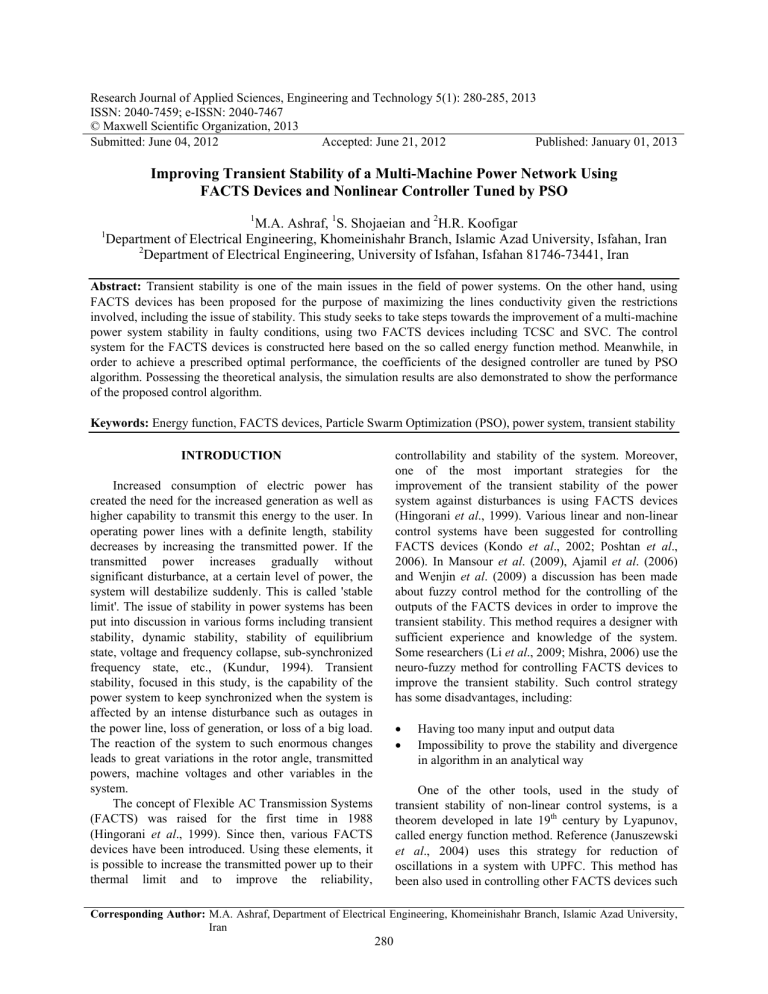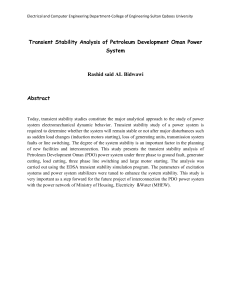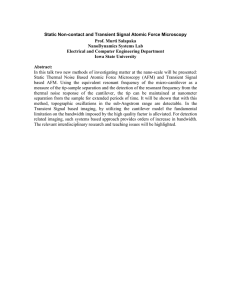Research Journal of Applied Sciences, Engineering and Technology 5(1): 280-285,... ISSN: 2040-7459; e-ISSN: 2040-7467
advertisement

Research Journal of Applied Sciences, Engineering and Technology 5(1): 280-285, 2013 ISSN: 2040-7459; e-ISSN: 2040-7467 © Maxwell Scientific Organization, 2013 Submitted: June 04, 2012 Accepted: June 21, 2012 Published: January 01, 2013 Improving Transient Stability of a Multi-Machine Power Network Using FACTS Devices and Nonlinear Controller Tuned by PSO 1 1 M.A. Ashraf, 1S. Shojaeian and 2H.R. Koofigar Department of Electrical Engineering, Khomeinishahr Branch, Islamic Azad University, Isfahan, Iran 2 Department of Electrical Engineering, University of Isfahan, Isfahan 81746-73441, Iran Abstract: Transient stability is one of the main issues in the field of power systems. On the other hand, using FACTS devices has been proposed for the purpose of maximizing the lines conductivity given the restrictions involved, including the issue of stability. This study seeks to take steps towards the improvement of a multi-machine power system stability in faulty conditions, using two FACTS devices including TCSC and SVC. The control system for the FACTS devices is constructed here based on the so called energy function method. Meanwhile, in order to achieve a prescribed optimal performance, the coefficients of the designed controller are tuned by PSO algorithm. Possessing the theoretical analysis, the simulation results are also demonstrated to show the performance of the proposed control algorithm. Keywords: Energy function, FACTS devices, Particle Swarm Optimization (PSO), power system, transient stability controllability and stability of the system. Moreover, one of the most important strategies for the improvement of the transient stability of the power system against disturbances is using FACTS devices (Hingorani et al., 1999). Various linear and non-linear control systems have been suggested for controlling FACTS devices (Kondo et al., 2002; Poshtan et al., 2006). In Mansour et al. (2009), Ajamil et al. (2006) and Wenjin et al. (2009) a discussion has been made about fuzzy control method for the controlling of the outputs of the FACTS devices in order to improve the transient stability. This method requires a designer with sufficient experience and knowledge of the system. Some researchers (Li et al., 2009; Mishra, 2006) use the neuro-fuzzy method for controlling FACTS devices to improve the transient stability. Such control strategy has some disadvantages, including: INTRODUCTION Increased consumption of electric power has created the need for the increased generation as well as higher capability to transmit this energy to the user. In operating power lines with a definite length, stability decreases by increasing the transmitted power. If the transmitted power increases gradually without significant disturbance, at a certain level of power, the system will destabilize suddenly. This is called 'stable limit'. The issue of stability in power systems has been put into discussion in various forms including transient stability, dynamic stability, stability of equilibrium state, voltage and frequency collapse, sub-synchronized frequency state, etc., (Kundur, 1994). Transient stability, focused in this study, is the capability of the power system to keep synchronized when the system is affected by an intense disturbance such as outages in the power line, loss of generation, or loss of a big load. The reaction of the system to such enormous changes leads to great variations in the rotor angle, transmitted powers, machine voltages and other variables in the system. The concept of Flexible AC Transmission Systems (FACTS) was raised for the first time in 1988 (Hingorani et al., 1999). Since then, various FACTS devices have been introduced. Using these elements, it is possible to increase the transmitted power up to their thermal limit and to improve the reliability, Having too many input and output data Impossibility to prove the stability and divergence in algorithm in an analytical way One of the other tools, used in the study of transient stability of non-linear control systems, is a theorem developed in late 19th century by Lyapunov, called energy function method. Reference (Januszewski et al., 2004) uses this strategy for reduction of oscillations in a system with UPFC. This method has been also used in controlling other FACTS devices such Corresponding Author: M.A. Ashraf, Department of Electrical Engineering, Khomeinishahr Branch, Islamic Azad University, Iran 280 Res. J. Appl. Sci. Eng. Technol., 5(1): 280-285, 2013 as resistance brakes (Machowski et al., 2001) and static compensator in series (Machowski et al., 1997). In this study, two FACTS elements with a control system based on energy function is proposed and applied to a 9-bus system for the improvement of its transient stability. Particle swarm optimization algorithm is adopted to tune the controller coefficients. Numerical analysis and various demonstrations are also provided to show the performance of the proposed method. MATERIALS AND METHODS The power system studied in this study is a IEEE standard 9-bus system, as shown in Fig. 1 and the parameters of elements of the system is given in Table 1. In such system, loads are used as constant impedances and the classical model of electrical machines is used for the analysis of synchronized machines. In order to facilitate studying the transient behavior of a power system, we investigate the generators rotor angles in a center of inertia frame. Since generator 1 has the greatest inertia, we can consider the power of , as the center of inertia and investigate the other generators with respect to it. The system under consideration uses two different FACTS devices that include a series element and a parallel element for compensation. Thyristor Controlled Series Compensators (TCSCs) are the first generation of FACTS devices that can control the impedance of the line through embedding a thyristor controlled capacitor in the power transmission line. The most significant feature of TCSC in stability analysis is its ability to eliminate power system oscillations. In fact, TCSC is a capacitor reactance compensator that is made of a capacitor bank and a paralleled thyristor controlled Fig. 1: A 9-bus power system Table 1: Parameters of multi-machine system Steam Steam Steam Sync-machines machine 1 machine 2 machine 3 H 7.5000 5.0000 5.0000 Xq 1.8000 1.8000 1.8000 Xd 1.8000 1.8000 1.8000 0.2000 0.2000 0.1900 Xls 0.1500 0.1500 0.1400 Xifd 0.0820 0.0800 0.0800 Xlkd 0.0820 0.0800 0.0800 Xlkq1 0.0900 0.0900 0.1000 XIkq2 Rs 0.0000 0.0040 0.0050 0.0010 0.0008 0.0009 Rfd 0.0133 0.0133 0.0133 Rkd 0.0020 0.0018 0.0180 Rkq1 0.0080 0.0085 0.0085 Rkq2 0.1000 0.5000 0.1000 Ta 10.000 20.000 20.000 Ka Reactance values are in p.u. on a 100 MVA base; All time constants are in seconds reactor whose model is schematically shown in Fig. 2. SVC, the other FACTS device, is a parallel compensator which is usually used as a means to adjust the voltage in the selected terminal. The SVC structure with its connection to the network is depicted in Fig. 3. VC i i i C L i iL C L SW Fig. 2: Circuit model of a TCSC Fig. 3: Circuit model of SVC RESULTS AND DISCUSSION One of the most suitable methods of studying the transient stability in power systems is based on the of Lyapunov direct method. The main argument of this method is the mathematical generalization of a fundamentally physical observation. That is, if all of the energy of a mechanical or electrical system is consumed on a continuous basis, that system, whether linear or non-linear, must ultimately be static at a point 281 Res. J. Appl. Sci. Eng. Technol., 5(1): 280-285, 2013 Table 2: Energy function parameters Parameters Explanation Parameters v Energy function PL M Mass QL ω δ P Velocity Generator angle Active power θ V Qs In order to have the maximum of improvement with the optimized values of admittance of SVC and TCSC, one can define an energy function for the system. In Pai (1989) and Hisken et al. (1992), energy function for a power system has been introduced with G generators and L loads which also include FACTS elements: Explanation Load active power Load reactive power Load angle Load voltage Compensator reactive power , of equilibrium. Therefore, it is possible to infer the stability of a system by examining the variations of a scalar function. Energy function, which is a scalar function and the energy function, is a particular representation of the Lyapunov method. In Haque (2004, 2005) it is proved that SVC and TCSC can improve transient stability by injecting susceptance and impedance respectively. The values of SVC susceptance and TCSC inductance comprise a static and a dynamic constituent the constants of which are 0.1 and 0.64 PU, respectively. Moreover: ∑ ∑ ∑ (3) Table 2 summarizes the energy function parameters. According to Lyapunov's stability theorem, if one can obtain such a stability that conforms to the system states so that the function is a positive definite one and its derivative stays in the neighborhood of the semi-definite equilibrium point, the system is stable in the sense of Lyapunov. Considering the aforementioned points, it is possible to derive the control law as follows: bp = bp0 + bPU (1) (4) Xs = Xso + XSU (2) (5) And Fig. 4: Result of optimization using PSO algorithm 282 Res. J. Appl. Sci. Eng. Technol., 5(1): 280-285, 2013 It must be noted that: Start Kp and Ks must be positive 0 Where equals Load flow analysis & calculate bus voltages and Calculate variation of machines in steady state equals Where equals and Send current of generators to network as current supply & then calculate generators voltages in every machine’s frame equals In Noroozian et al. (2001), the values of the coefficients of the control system are not clear, whereas the injected admittance values of FACT devices depends completely on these coefficients. This paper uses particle swarm optimization for the calculation of the values of the control coefficients. PSO, as inspired from some birds’ social behavior, has some advantages over other optimization methods such as: Solve the complete model of machine & calculate new δs, ψs, ωrs Control law & calculate Xtcsc and bsvc Limiters of Xtcsc and bsvc Possibility of adapting them to all systems for implementation High rate of convergence in comparison with other methods such as genetic algorithm Simplicity of algorithm due to the fact that the numbers are true numbers in this method (Eberhart et al., 1998) Insert disturbance & change admittance matrix, then calculate new voltages Calculate of PSO target function Perform PSO algorithm The cost function as defined for this minimizing algorithm is the area beneath the curve related to the difference between the power angles of machine 1 and machine 2: | | 180/ Is time over? No (6) Is optimization algorithm finished? For this optimization index, the number of particles has been taken as 10 and the stopping condition which is the maximum number of iterations equals 20. Figure 4 shows the results obtained from the PSO method for and with 10 as the the two variables of maximum number of particles and the coefficient values as the maximum number of iterations using PSO method and the defined cost function. Thus, for and we have 0.1014 and 1.1618, respectively. The flowchart in Fig. 5 has been developed in order to examine the effects of the FACTS devices with the proposed control system on transient stability of the system. Initially, we use Newton-Raphson load distribution method to calculate the currents and voltages of the system. Then we calculate the values of the voltages in each machine's frame and calculate the flows, angles and new velocities of the generators using the complete model of synchronous machine. After the calculation of the flows from the newly calculated values, we can enter FACTS values as No Finish Fig. 5: Program's flowchart Calculated into the system as admittance. To evaluate the status of the power system, a three phase short-cir cuit for 300 ms was put on a line between buses 7 and 8. Following the event, the line went offline after a disturbance of about 800 ms. The end of the flowchart is related to the calculation of the cost function for the optimization of PSO followed by the optimization of the coefficients of the control system. Programming and simulations are performed by MATLAB software. In Fig. 6, one can see the system status when in turbulence when remedying and non283 Res. J. Appl. Sci. Eng. Technol., 5(1): 280-285, 2013 Fig. 6: Status of , with FACTS devices (—) and without FACTS devices (--) Fig. 7: Controller based on energy function method with (-.) and without FACTS devices (—) compared to BANGBANG controller (--) optimized leading to the even further improvement of the transient stability in the power systems. remedying. It shows a comparison between the 2 and 3 machine power angles in case of the occurrence of short-circuits in the tow remedying and non-remedying states. The performance of the proposed control system is compared with that of a BANGBANG controller, constructed by: P X b P P P REFERENCES Ajamil, A. and S.H. Hosseini, 2006. Application of a fuzzy controller for transient stability enhancement of ac transmission system by STATCOM. SICEICASE Interenational Joint Conference, Busan, Korea. Eberhart, R.C. and Y. Shi, 1998. Comparison between genetic algorithms and particle swarm optimization. 7th Annual Conference on Evolutionary Programming, Springer-Verlag, Berlin, San Diego, CA. Haque, M.H., 2004. Improvement of first swing stability limit by utilizing full benefit of shunt FACTS devices. IEEE Trans. Power Syst., 19(4): 1984-1902. Haque, M.H., 2005. Use of series and shunt FACTS devices to improve first swing stability limit. 7th International Power Engineering Conference, Nov. 29 2005-Dec. 2 2005, Singapore, pp: 1-365. Hingorani, N.G. and L. Gyugyi, 1999. Understanding FACTS: Concepts and Technology of Flexible ac Transmission Systems. Wiley-IEEE Press, NY, pp: 452, ISBN: 0780334558. Hisken, I. and D. Hill, 1992. Incorporation of SVCs into energy function methods. IEEE Trans. Power Syst., 7(1): 133-140. (7) (8) In order to have a reasonable comparison, the coefficient of this system has been also optimized by PSO algorithm. In Fig. 7 you can see the acceptable performance of the control system on the basis of the energy function compared with a BANGBANG controller. CONCLUSION Transient stability, as an important issue in the study of power systems, is investigated. This paper seeks to improve it by an IEEE standard three bus system using FACTS devices. A control system is developed for controlling of the FACTS elements which is advantageous in terms of high rate of conversion, low inputs, generalizability to other systems over other controlling methods. Next, using the PSO method, the control system coefficients were 284 Res. J. Appl. Sci. Eng. Technol., 5(1): 280-285, 2013 Januszewski, M., J. Machowski and J.W. Bialek, 2004. Application of the direct Lyapunov method to improve damping of power swings by control of UPFC. IEE Proc. Gener. Transm. Distrib., 151(2): 252-260. Kondo, T., A. Yokoyama, M. Goto, H. Konishi, M. Sekoguchi, et al., 2002. Power system transient stability enhancement by STATCOM with nonlinear control system. Int. Conf. Power Syst. Technol., 3: 1908-1912. Kundur, P., 1994. Power System Stability and Control. McGraw-Hill Inc., USA, pp: 1176, ISBN-10: 007035958X. Li, Y. and C. Xiangjie, 2009. Research on RBF neural network fuzzy control for STATC0M. International Conference on Intelligent Human-Machine Systems and Cybernetics, (IHMSC '09), IEEE Computer Society Washington, DC, USA, pp: 413-416. Machowski, J., S. Robak and J. Bialek, 1997. Damping of power swings by optimal control of series compensators. Proceeding of 10th International Conference Power System Automation and Control, Bled, Slovenia, pp: 39-44. Machowski, J., A. Smolarczyk and J. Bialek, 2001. Damping of power swings by control of braking resistors. Int. J. Electr. Power Energ. Syst., 23: 539-548. Mansour, I., D.O. Abdeslam, P. Wira and J. Merckle, 2009. Fuzzy logic control of a SVC to improve the transient stability of AC power systems. 35th IEEE Annual Conference on Ind. Electronics, (IECON '09), Nov. 2009, pp: 3240-3245. Mishra, S., 2006. Neural-network-based adaptive UPFC for improving transient stability performance of power system. IEEE Trans. Neural Networ., 17(2): 461-470. Noroozian, M., M. Ghandhari, G. Andersson, J. Gronquist and I. Hiskens, 2001. A robust control strategy for shunt and series reactive compensators to damp electromechanical oscillations. IEEE Trans. Power Delivery, 16(4): 812-817. Pai, M.A., 1989. Energy Function Analysis for Power System Stability. Kluwer Academic Publishers, Boston. Poshtan, M., B.N. Singh and P. Rastgoufard, 2006. A nonlinear control method for SSSC to improve power system stability. International Conference on Power Electronics, Drives and Energy Systems, pp: 12-15. Wenjin, D. and C. Xiangjie, 2009. Research for STATCOM multi-objective fuzzy adaptive controller. International Conference on Future Information Engineering, pp: 418-422. 285


